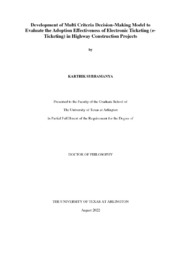
ATTENTION: The works hosted here are being migrated to a new repository that will consolidate resources, improve discoverability, and better show UTA's research impact on the global community. We will update authors as the migration progresses. Please see MavMatrix for more information.
Show simple item record
| dc.contributor.advisor | Kermanshachi, Sharareh | |
| dc.creator | Subramanya, Karthik | |
| dc.date.accessioned | 2023-06-26T21:45:54Z | |
| dc.date.available | 2023-06-26T21:45:54Z | |
| dc.date.created | 2022-08 | |
| dc.date.issued | 2022-08-16 | |
| dc.date.submitted | August 2022 | |
| dc.identifier.uri | http://hdl.handle.net/10106/31305 | |
| dc.description.abstract | Highway and bridge construction projects are subject to cost and schedule overruns, as well as workforce shortages in remote locations, both of which can result in disputes over the quality of the end product. State departments of transportation (DOTs) are constructing and managing more highway projects than ever before despite limited funds and a shortage of inspectors. The construction of highway infrastructure has devoted significant resources towards e-Construction to reduce the paperwork and automate the tasks in daily operations. Electronic Ticketing (e-Ticketing) is one such component of e-Construction that aids in the digital transfer of material tickets such as asphalt and concrete which accounts for more than fifty per cent of construction costs. Despite the benefits of e-Ticketing, many state departments and agencies are unwilling to transition into this technology. The technology has been pilot tested by several states since the beginning of 2013 and has been disbanded for various reasons. A few DOTs and general contractors have implemented e-Ticketing technology to increase their workforce productivity and efficiency, but the majority are still using conventional paper methods because they do not fully comprehend the benefits of the technology. No studies have identified the cause of the delay in the implementation process, developed a framework to comprehend the platform's full potential, quantified savings, and suggested strategies for overcoming limitations. Therefore, this study aims to (1) Indicate inefficiencies in the conventional paper ticketing framework and identify suitable technology to overcome the inefficiencies. (2) Identify benefits, quantify the reduction in inspection staff and time savings incurred by implementing e-Ticketing technology. (3) Develop a multi-criteria decision-making model for implementation of e-Ticketing platform in the perspective of state DOTs and general contractors. (4) Identify and rank the major limitations in the process of implementing e-Ticketing technology and suggest suitable strategies to overcome them.
To achieve the study's objective, the changes in technological trends in highway construction relating to material tracking, inspection, and digitization are qualitatively analyzed using meta-synthesis and interpretative analytical techniques. The review section is followed by a semi-structured interview of participants who work for the DOTs, general contractors, material vendors, and software vendors. The inductive thematic analysis approach was employed to analyze the interview transcripts using MAXQDA software. Later a survey was conducted to determine highway construction stakeholders’ opinions on critical readiness indicators, benefits, adoption levels and future integration of e-Ticketing technology. Based on the survey responses collected from 20 state DOTs, the study categorized the critical effectiveness indicators into 3 categories and ranked the operational challenges using the Relative Importance Index. The study analyses the critical effectiveness indicators (CEIs) of e-Ticketing technology and presents a fuzzy index-based decision-making model for evaluating the adoption priorities.
The findings from the literature review suggest that the implementation process and regulations of an e-Ticketing platform vary drastically from state to state and established 17 indicators which directly influence the adoption and readiness of e-Ticketing implementation. A framework comprising inefficiencies in conventional ticketing, key reasons for delayed implementations, and strategies to overcome the obstacles was derived from a thorough analysis of interview transcripts. A comparison was made between the required number of inspectors prior to and after the implementation of e-Ticketing, and it was found that projects requiring multiple inspectors could reduce their workforce by 25% by implementing e-Ticketing. The study's findings will assist practitioners with an assessment tool to gain insights relating to priority levels in implementing the e-Ticketing technology.
The e-Ticketing Effectiveness Index (EEI) model can provide the state DOTs and general contractors with a decision-making assessment tool which will facilitate in widespread adoption of e-Ticketing technology. The findings will also help DOT decision-makers and engineers to build a standard e-Ticketing platform, implement rules and guidelines, reduce project costs, provide initial funding, execute pilot testing, improve inspector safety, and complete projects in a timely and efficient manner. | |
| dc.format.mimetype | application/pdf | |
| dc.subject | Highway | |
| dc.subject | e-Ticketing | |
| dc.subject | DOT | |
| dc.subject | e-Construction | |
| dc.title | Development of Multi Criteria Decision-Making Model to Evaluate the Adoption Effectiveness of Electronic Ticketing (e-Ticketing) in Highway Construction Projects | |
| dc.type | Thesis | |
| dc.date.updated | 2023-06-26T21:45:54Z | |
| thesis.degree.department | Civil Engineering | |
| thesis.degree.grantor | The University of Texas at Arlington | |
| thesis.degree.level | Doctoral | |
| thesis.degree.name | Doctor of Philosophy in Civil Engineering | |
| dc.type.material | text | |
Files in this item
- Name:
- SUBRAMANYA-DISSERTATION-2022.pdf
- Size:
- 3.989Mb
- Format:
- PDF
This item appears in the following Collection(s)
Show simple item record


